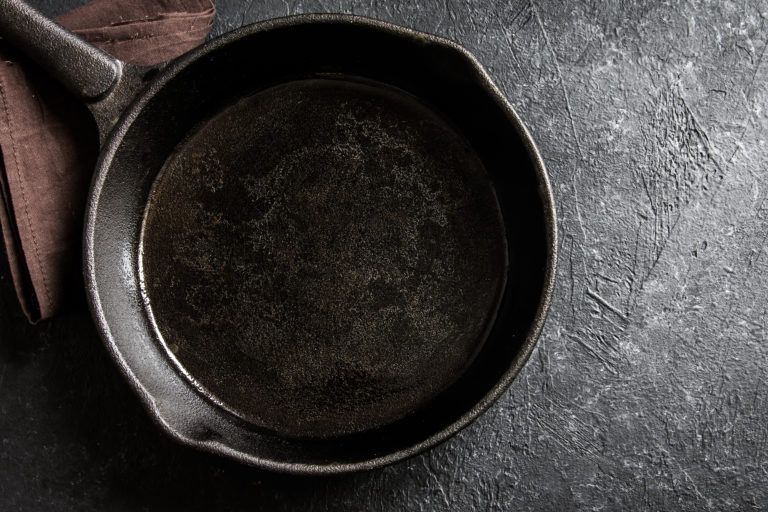
Quick Tips
You finally made the perfect pan-seared steak. Crispy, golden crust, juicy center—the kind of meal that makes you feel like a pro. But now comes the real test: cleaning your beloved cast iron skillet without destroying it. One wrong move and you’ll strip away years of seasoning, leaving behind a rusty mess. If you’re tired of second-guessing how to clean your pan properly, don’t worry. We’ve got you covered.
Why Cleaning Cast Iron Properly Matters
Cast iron isn’t just another pan—it’s a legacy piece. Proper care keeps it non-stick, rust-free, and cooking like a dream for decades (or longer). But neglecting to clean and maintain it properly can lead to stuck-on food, flaking seasoning, or worse, rust. Unlike other cookware, cast iron doesn’t play well with soap, soaking, or harsh scrubbing. Instead, cleaning it the right way helps preserve the seasoning (the natural, oil-based coating that makes it non-stick and rust-resistant). Whether you inherited your skillet from your grandmother or picked up a new one, treating it well means it’ll treat you well in return.
What You’ll Need for Proper Cast Iron Cleaning
Before you begin, gather the right tools to clean your skillet without ruining it:
- Hot water – Essential for loosening food particles without soap.
- Coarse kosher salt (optional) – A natural abrasive for stubborn bits.
- Non-abrasive scrub brush or sponge – To clean without stripping the seasoning.
- Clean, dry cloth or paper towels – For drying the pan completely.
- Vegetable oil or shortening – To maintain the seasoning.
- Aluminum foil – If you need to re-season.
How to Clean Cast Iron in 5 Steps
1. Clean the Skillet Immediately After Use
The best time to clean cast iron is right after cooking while the pan is still warm. This makes food particles easier to remove and prevents any moisture from lingering. Rinse the skillet under hot water and use a non-abrasive scrub brush or sponge to gently lift away food residue. If you have stuck-on bits, try coarse kosher salt as a scrubbing agent—just sprinkle some in the pan and use a sponge to rub it around. Avoid using dish soap, as it can strip the seasoning, and never, ever soak the pan in water, which leads to rust.
2. Dry the Skillet Thoroughly
Once your pan is clean, the most important thing you can do is dry it immediately. Leaving water in a cast iron pan—even for a few minutes—can start the rusting process. Use a clean cloth or paper towel to dry the entire surface, including the handle. For extra protection, place the skillet on a stovetop burner over low heat for 2-3 minutes to evaporate any remaining moisture. This ensures that no water remains in the pores of the metal, keeping rust at bay.
3. Apply a Thin Layer of Oil
After drying, it’s time to replenish the seasoning to keep your pan non-stick and protected. Add a few drops of vegetable oil, canola oil, or melted shortening to the pan while it’s still warm. Using a paper towel or cloth, spread the oil in a thin, even layer across the entire surface, including the sides and bottom. Make sure the pan isn’t greasy—too much oil can lead to a sticky residue instead of a smooth, seasoned finish. This step maintains your pan’s protective layer and prevents oxidation.
4. Store the Skillet Properly
Now that your skillet is clean and seasoned, store it in a dry place. Avoid stacking it with other cookware, as moisture trapped between pans can lead to rust. If you must stack it, place a paper towel between pans to absorb any excess moisture. Also, never store your skillet with the lid on—this can trap humidity inside and encourage rust formation. Instead, leave it in an open-air environment, preferably in a cabinet or hanging on a rack where air can circulate.
5. Re-Season When Necessary
If your skillet starts looking dull, patchy, or sticky, it’s time for a re-seasoning session. Preheat your oven to 350°F (175°C) and apply a thin coat of vegetable oil or shortening to the entire skillet. Place it upside down on the oven rack with a sheet of aluminum foil on the rack below to catch drips. Bake for one hour, then turn off the oven and let the skillet cool inside. This process restores the seasoning, creating a smooth, non-stick surface that improves with each use.
How Professional Chefs Maintain Cast Iron
Professional chefs swear by simple but consistent maintenance to keep cast iron in peak condition. Here’s what they do:
- Use cast iron daily – Frequent use keeps seasoning strong.
- Avoid acidic foods – Tomatoes and citrus can erode seasoning.
- Use flaxseed oil for seasoning – Creates a harder, more durable finish.
- Never scrub aggressively – Gentle cleaning preserves seasoning.
- Heat the pan before cooking – Ensures even heating and prevents sticking.
If your skillet has serious rust or flaking, consider professional restoration methods like electrolysis cleaning or deep seasoning treatments for a full revival.
How Often Should You Clean and Maintain Cast Iron?
- After every use: Rinse, dry, and apply oil.
- Monthly: Inspect for dull spots and re-season as needed.
- Every 6 months: Perform a deep seasoning bake if necessary.
- Annually: Check for any buildup or rust and restore as needed.
Final Thoughts
Caring for cast iron isn’t difficult, but it does require a bit of routine maintenance. By following these steps, you’ll keep your skillet non-stick, rust-free, and performing beautifully for generations. So go ahead—make that perfect steak, bake that cornbread, and let your cast iron be the kitchen workhorse it was meant to be.
For more expert kitchen cleaning tips, check out How to Clean Stainless Steel Pans. Keep your cookware in top shape and enjoy every meal!